Research Report: Youth Crime in the United Kingdom - 2024
VerifiedAdded on 2021/10/09
|54
|19559
|113
Report
AI Summary
This report, titled "An exploration of youth crime in the United Kingdom," investigates the multifaceted nature of juvenile delinquency in the UK, drawing upon interviews with young offenders aged 14-18 under court restrictions. The study examines the influence of social factors on delinquent behavior, particularly within the context of educational experiences, and applies Tajfel and Turner's Social Identity Theory (SIT) to interpret the findings. The research reveals that social issues are significant for all young offenders when identifying reasons for delinquent behavior, with a stronger perception among males. The report highlights the importance of peer groups in reinforcing pre-existing attitudes towards education and avoiding difficult educational tasks. It also explores the situational factors that support SIT. The report also analyses risk factors by domain, including individual, family, school, peer group, and community, as well as the impact of conduct disorder, race, ethnicity, child abuse, heredity, and drug trafficking. The study concludes with a discussion of the implications of these findings for school practices and educational counselors. The report also offers a comprehensive literature review encompassing the economic and social impact of youth violence, aggression attitudes, media influence, family functioning, peer pressure, drug and alcohol use, traumatic events, and mental illness.

An exploration of youth crime in the United Kingdom
Name: Rajdip Kaur
Student Number: 2011439
1
Name: Rajdip Kaur
Student Number: 2011439
1
Paraphrase This Document
Need a fresh take? Get an instant paraphrase of this document with our AI Paraphraser

Acknowledgements
I like to say thanks to the young people who took part in this study for sharing their experiences
with me. I'd like to thank the youth workers who took the time to talk with me about this study,
especially Pauline and Charalambous. Thanks to Oliver Sharp and Mark for being vital links with
the youth and for their excitement for the project. I'd also want to thank Cara and Ozarow for their
assistance, as well as my co-workers for their unwavering support, flexibility, and understanding
of the research process.
I am thankful to my supervisor for all of their help and support during this investigation. Their
comments have been quite helpful. Always been upbeat. Also, I'd want to thank my fellow
Trainee Educational Psychologists. Whose friendship and support have made it possible for me
to finish this research thesis? Lastly, I want to thank my family and friends.
2
I like to say thanks to the young people who took part in this study for sharing their experiences
with me. I'd like to thank the youth workers who took the time to talk with me about this study,
especially Pauline and Charalambous. Thanks to Oliver Sharp and Mark for being vital links with
the youth and for their excitement for the project. I'd also want to thank Cara and Ozarow for their
assistance, as well as my co-workers for their unwavering support, flexibility, and understanding
of the research process.
I am thankful to my supervisor for all of their help and support during this investigation. Their
comments have been quite helpful. Always been upbeat. Also, I'd want to thank my fellow
Trainee Educational Psychologists. Whose friendship and support have made it possible for me
to finish this research thesis? Lastly, I want to thank my family and friends.
2
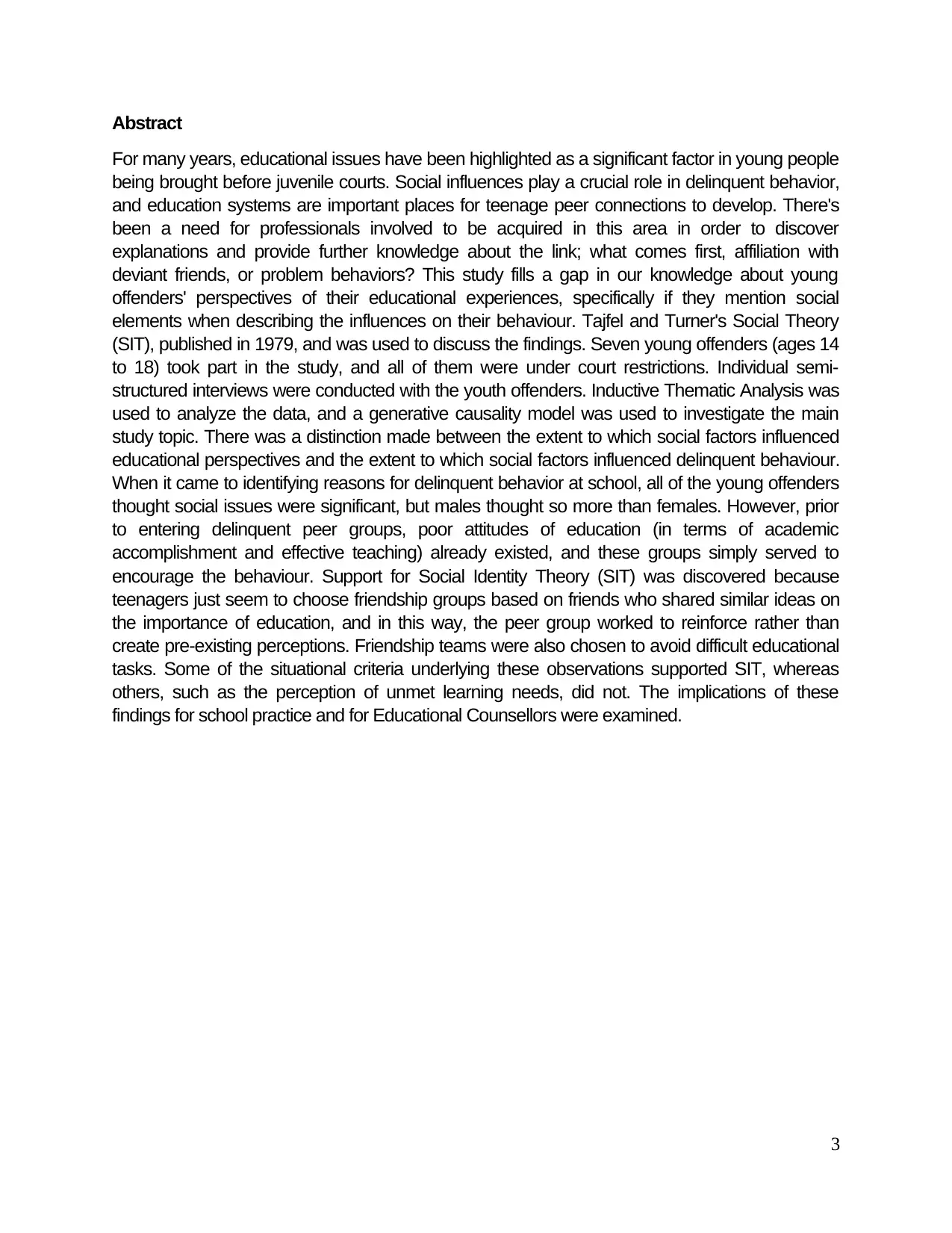
Abstract
For many years, educational issues have been highlighted as a significant factor in young people
being brought before juvenile courts. Social influences play a crucial role in delinquent behavior,
and education systems are important places for teenage peer connections to develop. There's
been a need for professionals involved to be acquired in this area in order to discover
explanations and provide further knowledge about the link; what comes first, affiliation with
deviant friends, or problem behaviors? This study fills a gap in our knowledge about young
offenders' perspectives of their educational experiences, specifically if they mention social
elements when describing the influences on their behaviour. Tajfel and Turner's Social Theory
(SIT), published in 1979, and was used to discuss the findings. Seven young offenders (ages 14
to 18) took part in the study, and all of them were under court restrictions. Individual semi-
structured interviews were conducted with the youth offenders. Inductive Thematic Analysis was
used to analyze the data, and a generative causality model was used to investigate the main
study topic. There was a distinction made between the extent to which social factors influenced
educational perspectives and the extent to which social factors influenced delinquent behaviour.
When it came to identifying reasons for delinquent behavior at school, all of the young offenders
thought social issues were significant, but males thought so more than females. However, prior
to entering delinquent peer groups, poor attitudes of education (in terms of academic
accomplishment and effective teaching) already existed, and these groups simply served to
encourage the behaviour. Support for Social Identity Theory (SIT) was discovered because
teenagers just seem to choose friendship groups based on friends who shared similar ideas on
the importance of education, and in this way, the peer group worked to reinforce rather than
create pre-existing perceptions. Friendship teams were also chosen to avoid difficult educational
tasks. Some of the situational criteria underlying these observations supported SIT, whereas
others, such as the perception of unmet learning needs, did not. The implications of these
findings for school practice and for Educational Counsellors were examined.
3
For many years, educational issues have been highlighted as a significant factor in young people
being brought before juvenile courts. Social influences play a crucial role in delinquent behavior,
and education systems are important places for teenage peer connections to develop. There's
been a need for professionals involved to be acquired in this area in order to discover
explanations and provide further knowledge about the link; what comes first, affiliation with
deviant friends, or problem behaviors? This study fills a gap in our knowledge about young
offenders' perspectives of their educational experiences, specifically if they mention social
elements when describing the influences on their behaviour. Tajfel and Turner's Social Theory
(SIT), published in 1979, and was used to discuss the findings. Seven young offenders (ages 14
to 18) took part in the study, and all of them were under court restrictions. Individual semi-
structured interviews were conducted with the youth offenders. Inductive Thematic Analysis was
used to analyze the data, and a generative causality model was used to investigate the main
study topic. There was a distinction made between the extent to which social factors influenced
educational perspectives and the extent to which social factors influenced delinquent behaviour.
When it came to identifying reasons for delinquent behavior at school, all of the young offenders
thought social issues were significant, but males thought so more than females. However, prior
to entering delinquent peer groups, poor attitudes of education (in terms of academic
accomplishment and effective teaching) already existed, and these groups simply served to
encourage the behaviour. Support for Social Identity Theory (SIT) was discovered because
teenagers just seem to choose friendship groups based on friends who shared similar ideas on
the importance of education, and in this way, the peer group worked to reinforce rather than
create pre-existing perceptions. Friendship teams were also chosen to avoid difficult educational
tasks. Some of the situational criteria underlying these observations supported SIT, whereas
others, such as the perception of unmet learning needs, did not. The implications of these
findings for school practice and for Educational Counsellors were examined.
3
⊘ This is a preview!⊘
Do you want full access?
Subscribe today to unlock all pages.

Trusted by 1+ million students worldwide
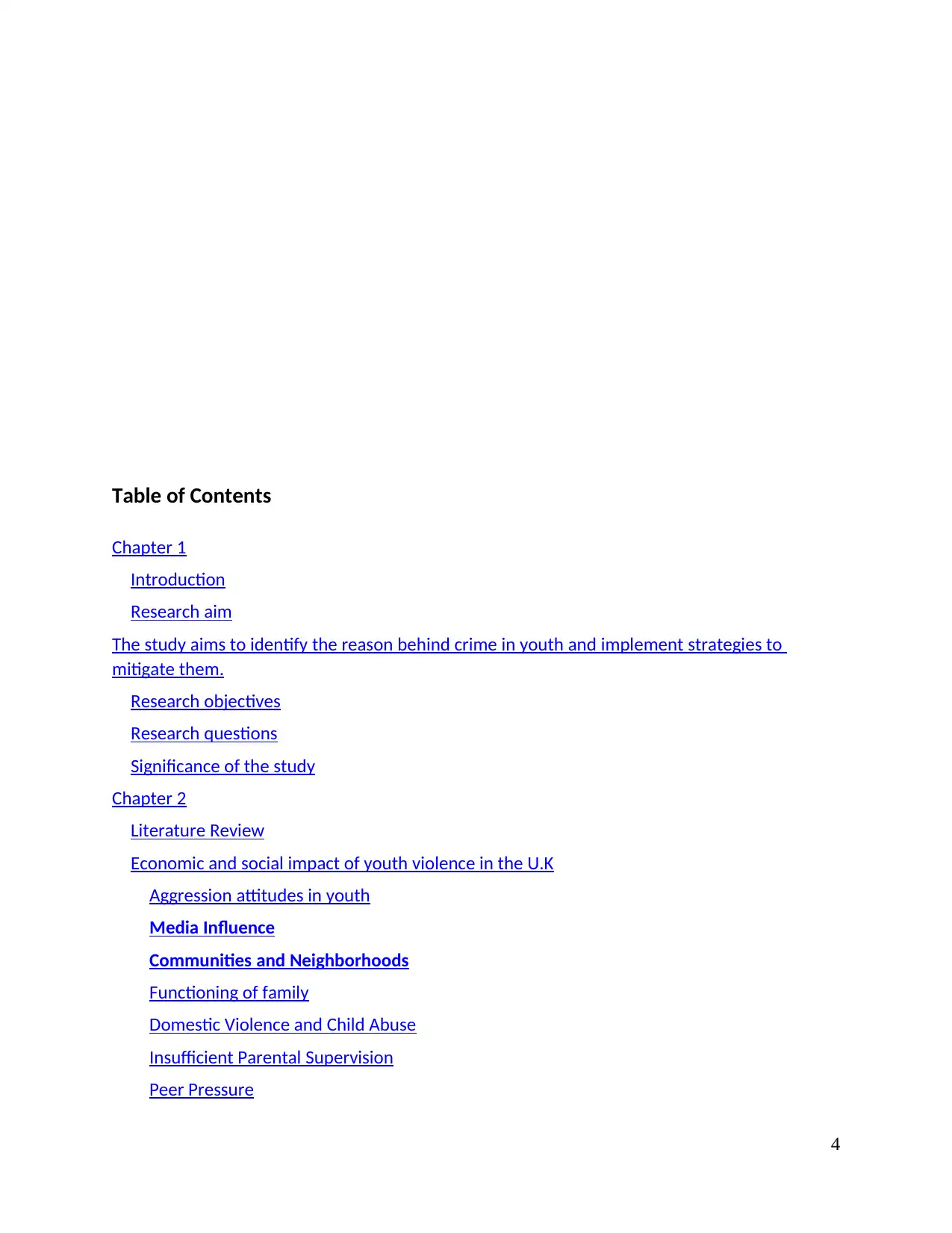
Table of Contents
Chapter 1
Introduction
Research aim
The study aims to identify the reason behind crime in youth and implement strategies to
mitigate them.
Research objectives
Research questions
Significance of the study
Chapter 2
Literature Review
Economic and social impact of youth violence in the U.K
Aggression attitudes in youth
Media Influence
Communities and Neighborhoods
Functioning of family
Domestic Violence and Child Abuse
Insufficient Parental Supervision
Peer Pressure
4
Chapter 1
Introduction
Research aim
The study aims to identify the reason behind crime in youth and implement strategies to
mitigate them.
Research objectives
Research questions
Significance of the study
Chapter 2
Literature Review
Economic and social impact of youth violence in the U.K
Aggression attitudes in youth
Media Influence
Communities and Neighborhoods
Functioning of family
Domestic Violence and Child Abuse
Insufficient Parental Supervision
Peer Pressure
4
Paraphrase This Document
Need a fresh take? Get an instant paraphrase of this document with our AI Paraphraser
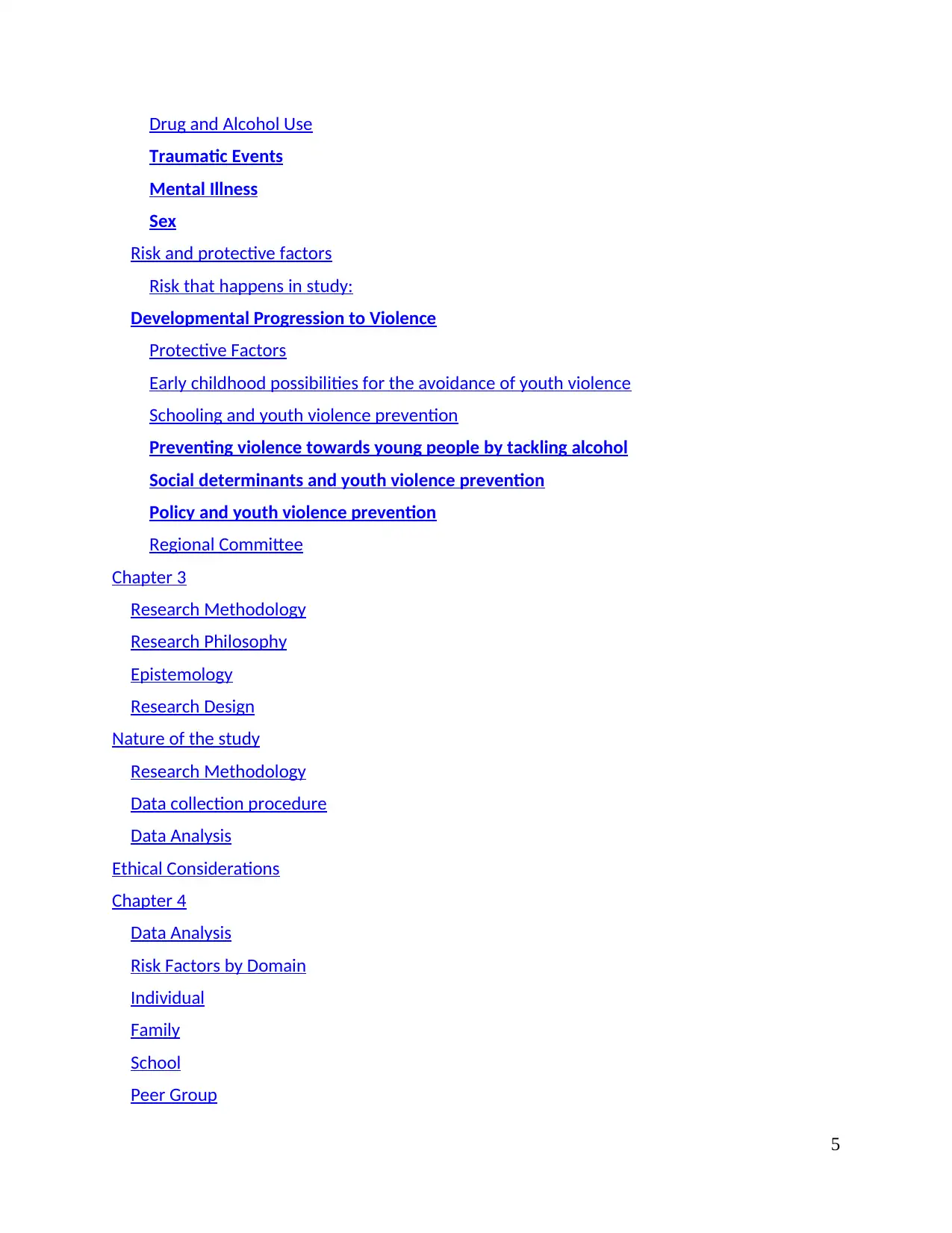
Drug and Alcohol Use
Traumatic Events
Mental Illness
Sex
Risk and protective factors
Risk that happens in study:
Developmental Progression to Violence
Protective Factors
Early childhood possibilities for the avoidance of youth violence
Schooling and youth violence prevention
Preventing violence towards young people by tackling alcohol
Social determinants and youth violence prevention
Policy and youth violence prevention
Regional Committee
Chapter 3
Research Methodology
Research Philosophy
Epistemology
Research Design
Nature of the study
Research Methodology
Data collection procedure
Data Analysis
Ethical Considerations
Chapter 4
Data Analysis
Risk Factors by Domain
Individual
Family
School
Peer Group
5
Traumatic Events
Mental Illness
Sex
Risk and protective factors
Risk that happens in study:
Developmental Progression to Violence
Protective Factors
Early childhood possibilities for the avoidance of youth violence
Schooling and youth violence prevention
Preventing violence towards young people by tackling alcohol
Social determinants and youth violence prevention
Policy and youth violence prevention
Regional Committee
Chapter 3
Research Methodology
Research Philosophy
Epistemology
Research Design
Nature of the study
Research Methodology
Data collection procedure
Data Analysis
Ethical Considerations
Chapter 4
Data Analysis
Risk Factors by Domain
Individual
Family
School
Peer Group
5

Community
Conduct disorder
Race
Ethnicity
Child abuse
Heredity
Drug trafficking
Chapter 5
Conclusion
References
6
Conduct disorder
Race
Ethnicity
Child abuse
Heredity
Drug trafficking
Chapter 5
Conclusion
References
6
⊘ This is a preview!⊘
Do you want full access?
Subscribe today to unlock all pages.

Trusted by 1+ million students worldwide
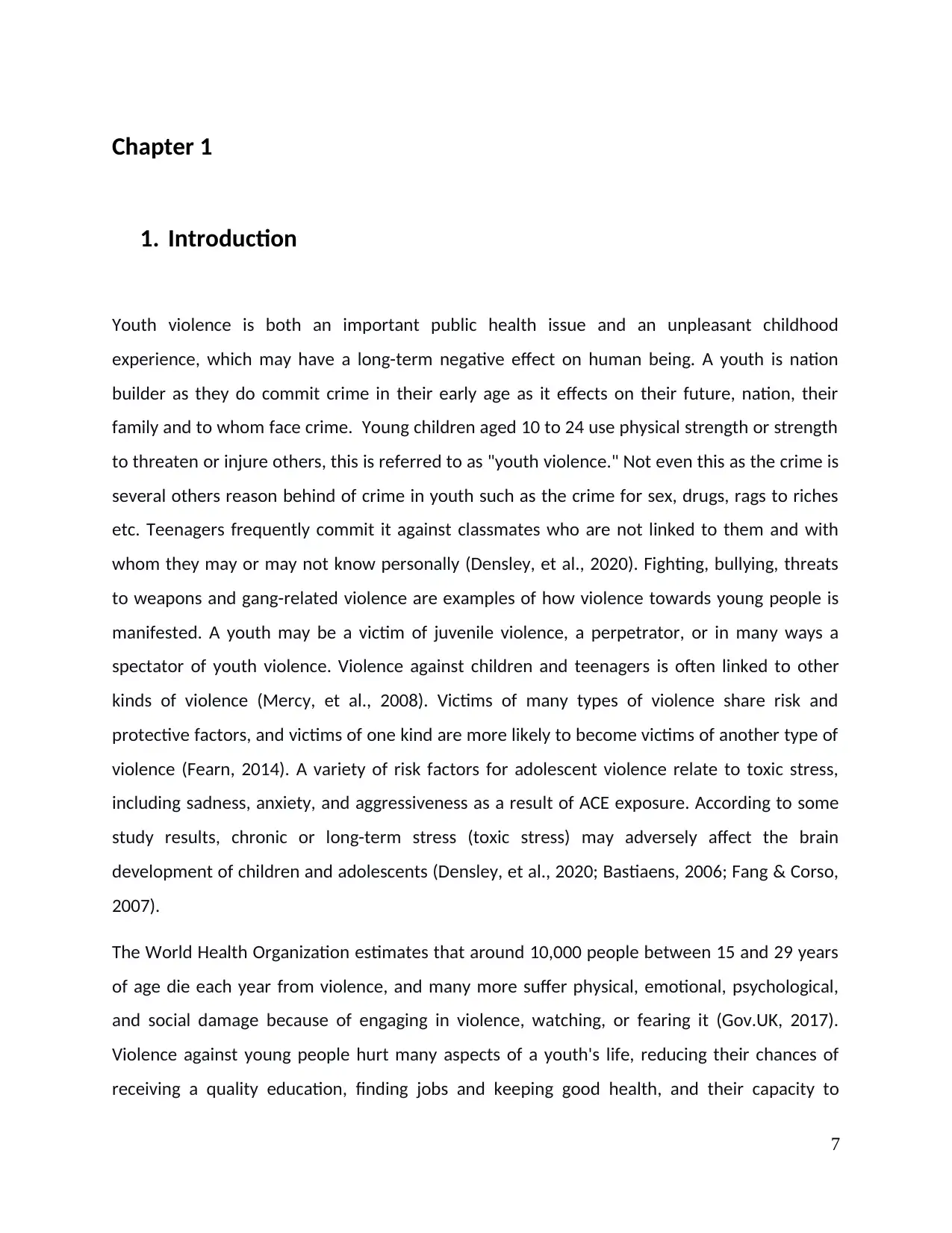
Chapter 1
1. Introduction
Youth violence is both an important public health issue and an unpleasant childhood
experience, which may have a long-term negative effect on human being. A youth is nation
builder as they do commit crime in their early age as it effects on their future, nation, their
family and to whom face crime. Young children aged 10 to 24 use physical strength or strength
to threaten or injure others, this is referred to as "youth violence." Not even this as the crime is
several others reason behind of crime in youth such as the crime for sex, drugs, rags to riches
etc. Teenagers frequently commit it against classmates who are not linked to them and with
whom they may or may not know personally (Densley, et al., 2020). Fighting, bullying, threats
to weapons and gang-related violence are examples of how violence towards young people is
manifested. A youth may be a victim of juvenile violence, a perpetrator, or in many ways a
spectator of youth violence. Violence against children and teenagers is often linked to other
kinds of violence (Mercy, et al., 2008). Victims of many types of violence share risk and
protective factors, and victims of one kind are more likely to become victims of another type of
violence (Fearn, 2014). A variety of risk factors for adolescent violence relate to toxic stress,
including sadness, anxiety, and aggressiveness as a result of ACE exposure. According to some
study results, chronic or long-term stress (toxic stress) may adversely affect the brain
development of children and adolescents (Densley, et al., 2020; Bastiaens, 2006; Fang & Corso,
2007).
The World Health Organization estimates that around 10,000 people between 15 and 29 years
of age die each year from violence, and many more suffer physical, emotional, psychological,
and social damage because of engaging in violence, watching, or fearing it (Gov.UK, 2017).
Violence against young people hurt many aspects of a youth's life, reducing their chances of
receiving a quality education, finding jobs and keeping good health, and their capacity to
7
1. Introduction
Youth violence is both an important public health issue and an unpleasant childhood
experience, which may have a long-term negative effect on human being. A youth is nation
builder as they do commit crime in their early age as it effects on their future, nation, their
family and to whom face crime. Young children aged 10 to 24 use physical strength or strength
to threaten or injure others, this is referred to as "youth violence." Not even this as the crime is
several others reason behind of crime in youth such as the crime for sex, drugs, rags to riches
etc. Teenagers frequently commit it against classmates who are not linked to them and with
whom they may or may not know personally (Densley, et al., 2020). Fighting, bullying, threats
to weapons and gang-related violence are examples of how violence towards young people is
manifested. A youth may be a victim of juvenile violence, a perpetrator, or in many ways a
spectator of youth violence. Violence against children and teenagers is often linked to other
kinds of violence (Mercy, et al., 2008). Victims of many types of violence share risk and
protective factors, and victims of one kind are more likely to become victims of another type of
violence (Fearn, 2014). A variety of risk factors for adolescent violence relate to toxic stress,
including sadness, anxiety, and aggressiveness as a result of ACE exposure. According to some
study results, chronic or long-term stress (toxic stress) may adversely affect the brain
development of children and adolescents (Densley, et al., 2020; Bastiaens, 2006; Fang & Corso,
2007).
The World Health Organization estimates that around 10,000 people between 15 and 29 years
of age die each year from violence, and many more suffer physical, emotional, psychological,
and social damage because of engaging in violence, watching, or fearing it (Gov.UK, 2017).
Violence against young people hurt many aspects of a youth's life, reducing their chances of
receiving a quality education, finding jobs and keeping good health, and their capacity to
7
Paraphrase This Document
Need a fresh take? Get an instant paraphrase of this document with our AI Paraphraser
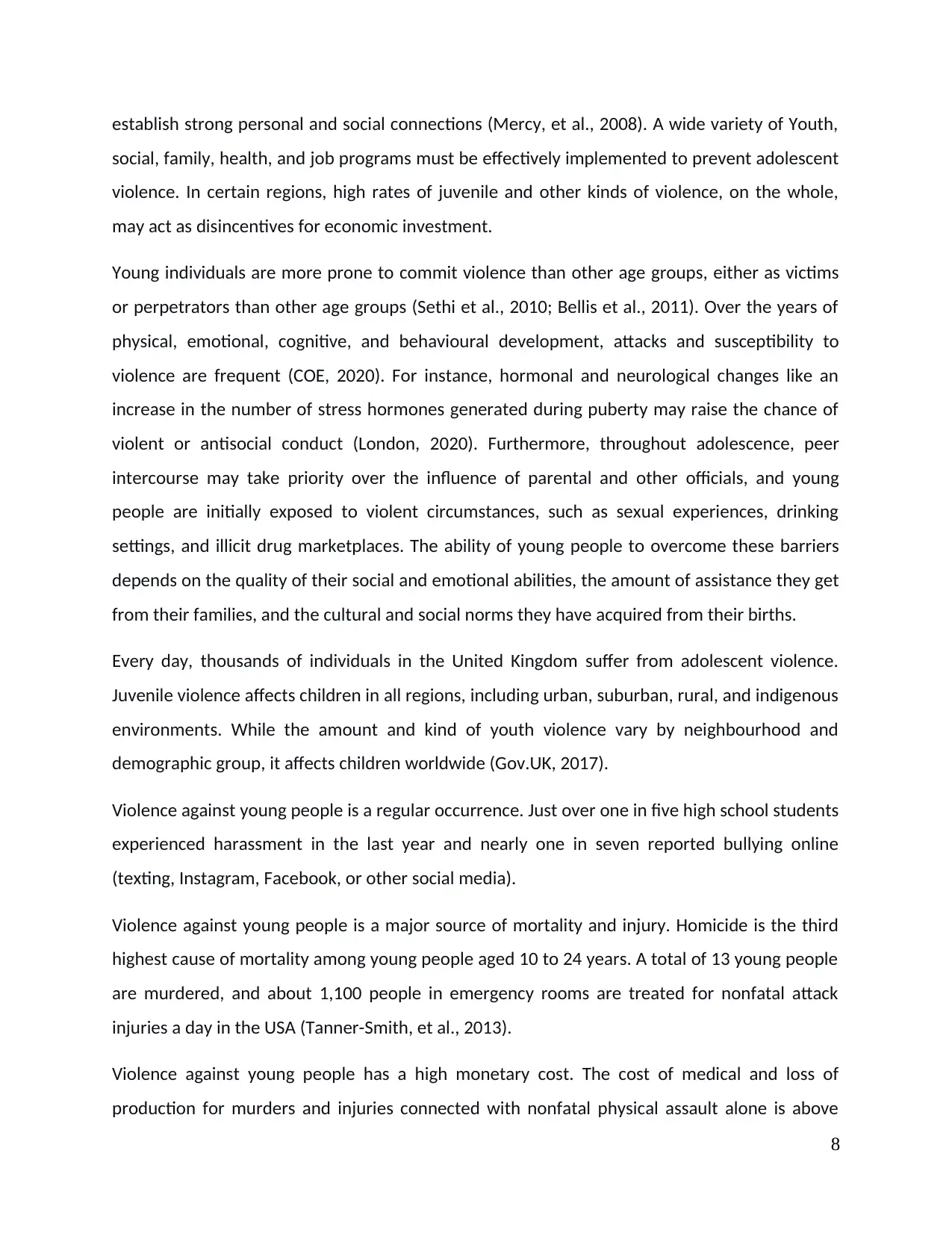
establish strong personal and social connections (Mercy, et al., 2008). A wide variety of Youth,
social, family, health, and job programs must be effectively implemented to prevent adolescent
violence. In certain regions, high rates of juvenile and other kinds of violence, on the whole,
may act as disincentives for economic investment.
Young individuals are more prone to commit violence than other age groups, either as victims
or perpetrators than other age groups (Sethi et al., 2010; Bellis et al., 2011). Over the years of
physical, emotional, cognitive, and behavioural development, attacks and susceptibility to
violence are frequent (COE, 2020). For instance, hormonal and neurological changes like an
increase in the number of stress hormones generated during puberty may raise the chance of
violent or antisocial conduct (London, 2020). Furthermore, throughout adolescence, peer
intercourse may take priority over the influence of parental and other officials, and young
people are initially exposed to violent circumstances, such as sexual experiences, drinking
settings, and illicit drug marketplaces. The ability of young people to overcome these barriers
depends on the quality of their social and emotional abilities, the amount of assistance they get
from their families, and the cultural and social norms they have acquired from their births.
Every day, thousands of individuals in the United Kingdom suffer from adolescent violence.
Juvenile violence affects children in all regions, including urban, suburban, rural, and indigenous
environments. While the amount and kind of youth violence vary by neighbourhood and
demographic group, it affects children worldwide (Gov.UK, 2017).
Violence against young people is a regular occurrence. Just over one in five high school students
experienced harassment in the last year and nearly one in seven reported bullying online
(texting, Instagram, Facebook, or other social media).
Violence against young people is a major source of mortality and injury. Homicide is the third
highest cause of mortality among young people aged 10 to 24 years. A total of 13 young people
are murdered, and about 1,100 people in emergency rooms are treated for nonfatal attack
injuries a day in the USA (Tanner-Smith, et al., 2013).
Violence against young people has a high monetary cost. The cost of medical and loss of
production for murders and injuries connected with nonfatal physical assault alone is above
8
social, family, health, and job programs must be effectively implemented to prevent adolescent
violence. In certain regions, high rates of juvenile and other kinds of violence, on the whole,
may act as disincentives for economic investment.
Young individuals are more prone to commit violence than other age groups, either as victims
or perpetrators than other age groups (Sethi et al., 2010; Bellis et al., 2011). Over the years of
physical, emotional, cognitive, and behavioural development, attacks and susceptibility to
violence are frequent (COE, 2020). For instance, hormonal and neurological changes like an
increase in the number of stress hormones generated during puberty may raise the chance of
violent or antisocial conduct (London, 2020). Furthermore, throughout adolescence, peer
intercourse may take priority over the influence of parental and other officials, and young
people are initially exposed to violent circumstances, such as sexual experiences, drinking
settings, and illicit drug marketplaces. The ability of young people to overcome these barriers
depends on the quality of their social and emotional abilities, the amount of assistance they get
from their families, and the cultural and social norms they have acquired from their births.
Every day, thousands of individuals in the United Kingdom suffer from adolescent violence.
Juvenile violence affects children in all regions, including urban, suburban, rural, and indigenous
environments. While the amount and kind of youth violence vary by neighbourhood and
demographic group, it affects children worldwide (Gov.UK, 2017).
Violence against young people is a regular occurrence. Just over one in five high school students
experienced harassment in the last year and nearly one in seven reported bullying online
(texting, Instagram, Facebook, or other social media).
Violence against young people is a major source of mortality and injury. Homicide is the third
highest cause of mortality among young people aged 10 to 24 years. A total of 13 young people
are murdered, and about 1,100 people in emergency rooms are treated for nonfatal attack
injuries a day in the USA (Tanner-Smith, et al., 2013).
Violence against young people has a high monetary cost. The cost of medical and loss of
production for murders and injuries connected with nonfatal physical assault alone is above
8
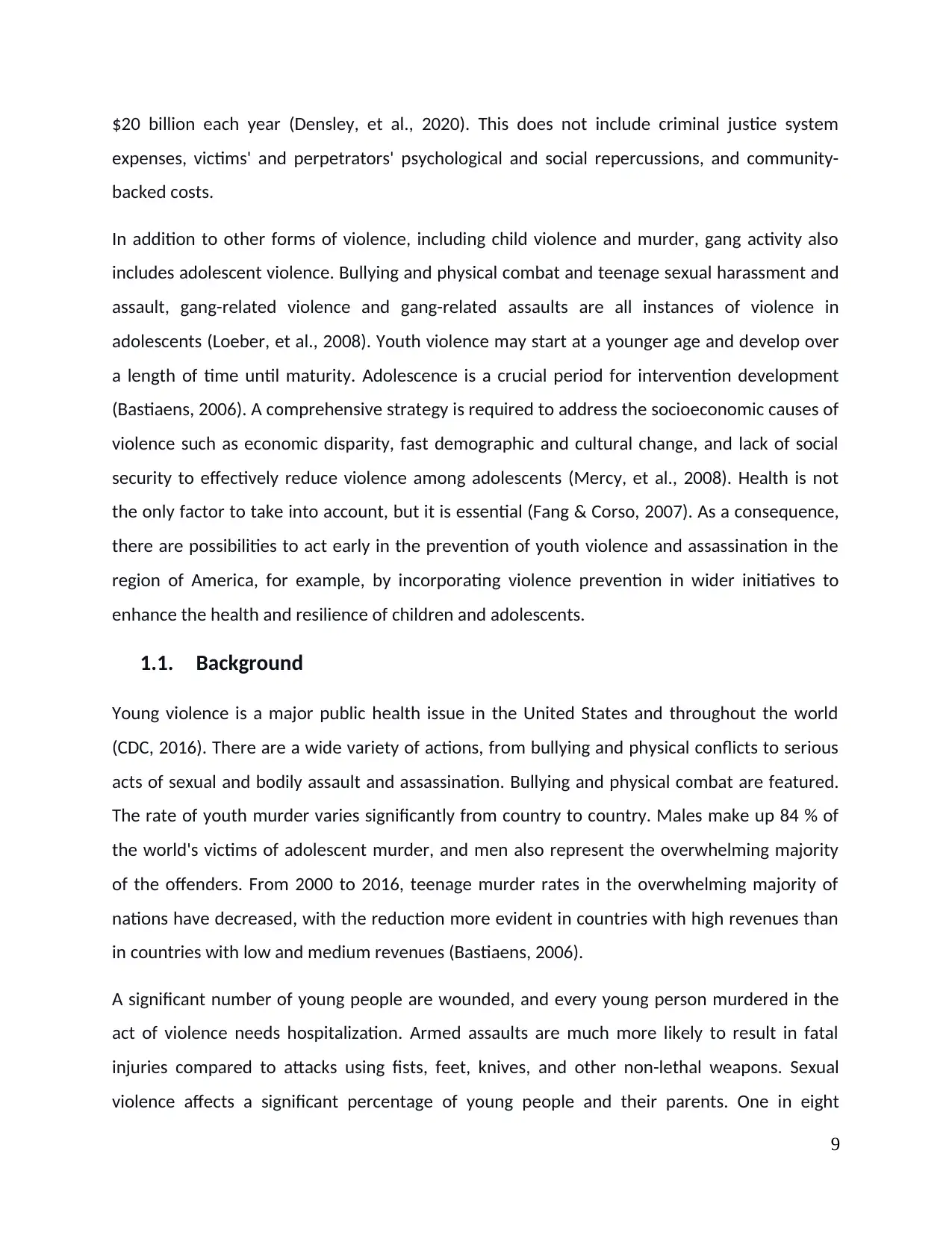
$20 billion each year (Densley, et al., 2020). This does not include criminal justice system
expenses, victims' and perpetrators' psychological and social repercussions, and community-
backed costs.
In addition to other forms of violence, including child violence and murder, gang activity also
includes adolescent violence. Bullying and physical combat and teenage sexual harassment and
assault, gang-related violence and gang-related assaults are all instances of violence in
adolescents (Loeber, et al., 2008). Youth violence may start at a younger age and develop over
a length of time until maturity. Adolescence is a crucial period for intervention development
(Bastiaens, 2006). A comprehensive strategy is required to address the socioeconomic causes of
violence such as economic disparity, fast demographic and cultural change, and lack of social
security to effectively reduce violence among adolescents (Mercy, et al., 2008). Health is not
the only factor to take into account, but it is essential (Fang & Corso, 2007). As a consequence,
there are possibilities to act early in the prevention of youth violence and assassination in the
region of America, for example, by incorporating violence prevention in wider initiatives to
enhance the health and resilience of children and adolescents.
1.1. Background
Young violence is a major public health issue in the United States and throughout the world
(CDC, 2016). There are a wide variety of actions, from bullying and physical conflicts to serious
acts of sexual and bodily assault and assassination. Bullying and physical combat are featured.
The rate of youth murder varies significantly from country to country. Males make up 84 % of
the world's victims of adolescent murder, and men also represent the overwhelming majority
of the offenders. From 2000 to 2016, teenage murder rates in the overwhelming majority of
nations have decreased, with the reduction more evident in countries with high revenues than
in countries with low and medium revenues (Bastiaens, 2006).
A significant number of young people are wounded, and every young person murdered in the
act of violence needs hospitalization. Armed assaults are much more likely to result in fatal
injuries compared to attacks using fists, feet, knives, and other non-lethal weapons. Sexual
violence affects a significant percentage of young people and their parents. One in eight
9
expenses, victims' and perpetrators' psychological and social repercussions, and community-
backed costs.
In addition to other forms of violence, including child violence and murder, gang activity also
includes adolescent violence. Bullying and physical combat and teenage sexual harassment and
assault, gang-related violence and gang-related assaults are all instances of violence in
adolescents (Loeber, et al., 2008). Youth violence may start at a younger age and develop over
a length of time until maturity. Adolescence is a crucial period for intervention development
(Bastiaens, 2006). A comprehensive strategy is required to address the socioeconomic causes of
violence such as economic disparity, fast demographic and cultural change, and lack of social
security to effectively reduce violence among adolescents (Mercy, et al., 2008). Health is not
the only factor to take into account, but it is essential (Fang & Corso, 2007). As a consequence,
there are possibilities to act early in the prevention of youth violence and assassination in the
region of America, for example, by incorporating violence prevention in wider initiatives to
enhance the health and resilience of children and adolescents.
1.1. Background
Young violence is a major public health issue in the United States and throughout the world
(CDC, 2016). There are a wide variety of actions, from bullying and physical conflicts to serious
acts of sexual and bodily assault and assassination. Bullying and physical combat are featured.
The rate of youth murder varies significantly from country to country. Males make up 84 % of
the world's victims of adolescent murder, and men also represent the overwhelming majority
of the offenders. From 2000 to 2016, teenage murder rates in the overwhelming majority of
nations have decreased, with the reduction more evident in countries with high revenues than
in countries with low and medium revenues (Bastiaens, 2006).
A significant number of young people are wounded, and every young person murdered in the
act of violence needs hospitalization. Armed assaults are much more likely to result in fatal
injuries compared to attacks using fists, feet, knives, and other non-lethal weapons. Sexual
violence affects a significant percentage of young people and their parents. One in eight
9
⊘ This is a preview!⊘
Do you want full access?
Subscribe today to unlock all pages.

Trusted by 1+ million students worldwide
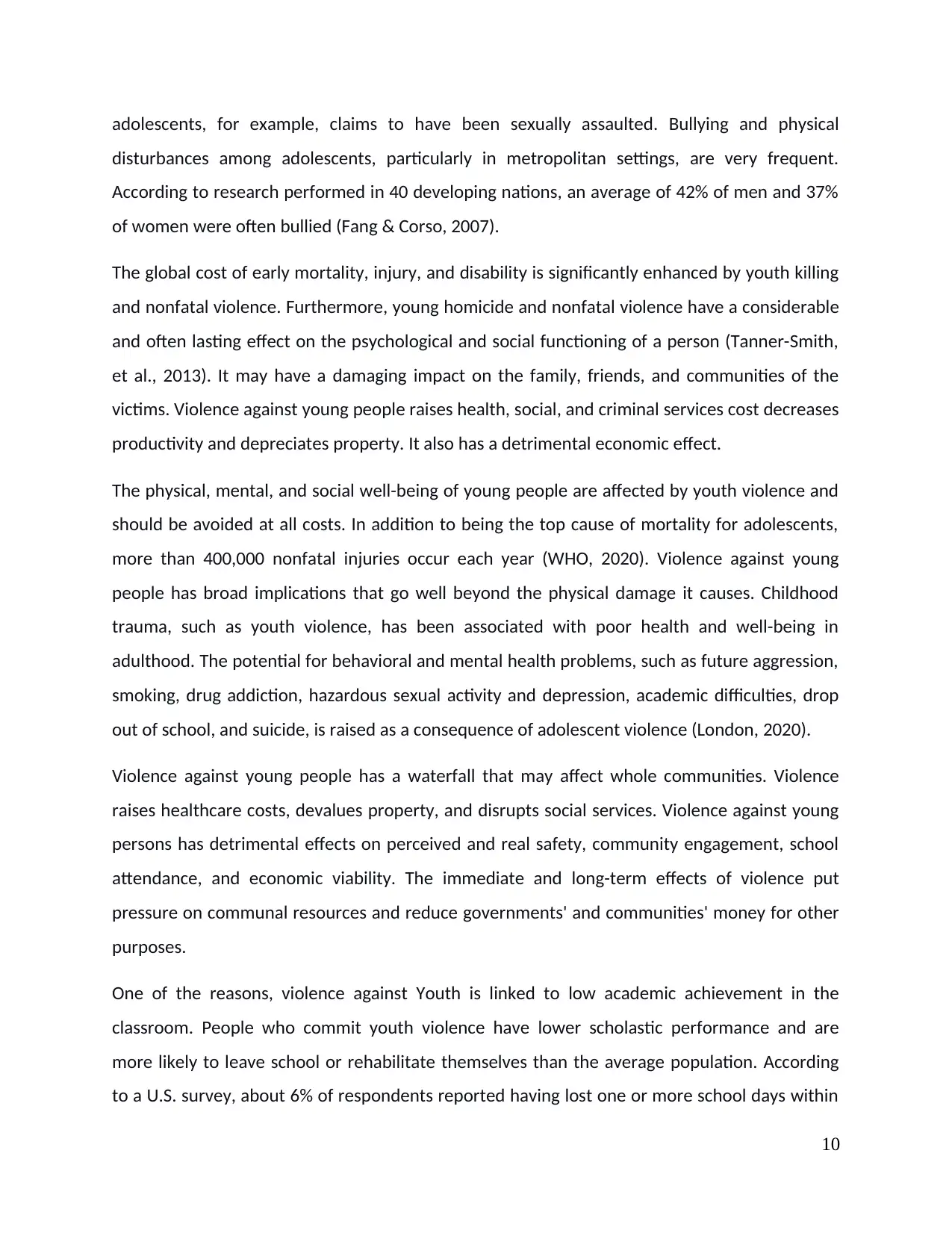
adolescents, for example, claims to have been sexually assaulted. Bullying and physical
disturbances among adolescents, particularly in metropolitan settings, are very frequent.
According to research performed in 40 developing nations, an average of 42% of men and 37%
of women were often bullied (Fang & Corso, 2007).
The global cost of early mortality, injury, and disability is significantly enhanced by youth killing
and nonfatal violence. Furthermore, young homicide and nonfatal violence have a considerable
and often lasting effect on the psychological and social functioning of a person (Tanner-Smith,
et al., 2013). It may have a damaging impact on the family, friends, and communities of the
victims. Violence against young people raises health, social, and criminal services cost decreases
productivity and depreciates property. It also has a detrimental economic effect.
The physical, mental, and social well-being of young people are affected by youth violence and
should be avoided at all costs. In addition to being the top cause of mortality for adolescents,
more than 400,000 nonfatal injuries occur each year (WHO, 2020). Violence against young
people has broad implications that go well beyond the physical damage it causes. Childhood
trauma, such as youth violence, has been associated with poor health and well-being in
adulthood. The potential for behavioral and mental health problems, such as future aggression,
smoking, drug addiction, hazardous sexual activity and depression, academic difficulties, drop
out of school, and suicide, is raised as a consequence of adolescent violence (London, 2020).
Violence against young people has a waterfall that may affect whole communities. Violence
raises healthcare costs, devalues property, and disrupts social services. Violence against young
persons has detrimental effects on perceived and real safety, community engagement, school
attendance, and economic viability. The immediate and long-term effects of violence put
pressure on communal resources and reduce governments' and communities' money for other
purposes.
One of the reasons, violence against Youth is linked to low academic achievement in the
classroom. People who commit youth violence have lower scholastic performance and are
more likely to leave school or rehabilitate themselves than the average population. According
to a U.S. survey, about 6% of respondents reported having lost one or more school days within
10
disturbances among adolescents, particularly in metropolitan settings, are very frequent.
According to research performed in 40 developing nations, an average of 42% of men and 37%
of women were often bullied (Fang & Corso, 2007).
The global cost of early mortality, injury, and disability is significantly enhanced by youth killing
and nonfatal violence. Furthermore, young homicide and nonfatal violence have a considerable
and often lasting effect on the psychological and social functioning of a person (Tanner-Smith,
et al., 2013). It may have a damaging impact on the family, friends, and communities of the
victims. Violence against young people raises health, social, and criminal services cost decreases
productivity and depreciates property. It also has a detrimental economic effect.
The physical, mental, and social well-being of young people are affected by youth violence and
should be avoided at all costs. In addition to being the top cause of mortality for adolescents,
more than 400,000 nonfatal injuries occur each year (WHO, 2020). Violence against young
people has broad implications that go well beyond the physical damage it causes. Childhood
trauma, such as youth violence, has been associated with poor health and well-being in
adulthood. The potential for behavioral and mental health problems, such as future aggression,
smoking, drug addiction, hazardous sexual activity and depression, academic difficulties, drop
out of school, and suicide, is raised as a consequence of adolescent violence (London, 2020).
Violence against young people has a waterfall that may affect whole communities. Violence
raises healthcare costs, devalues property, and disrupts social services. Violence against young
persons has detrimental effects on perceived and real safety, community engagement, school
attendance, and economic viability. The immediate and long-term effects of violence put
pressure on communal resources and reduce governments' and communities' money for other
purposes.
One of the reasons, violence against Youth is linked to low academic achievement in the
classroom. People who commit youth violence have lower scholastic performance and are
more likely to leave school or rehabilitate themselves than the average population. According
to a U.S. survey, about 6% of respondents reported having lost one or more school days within
10
Paraphrase This Document
Need a fresh take? Get an instant paraphrase of this document with our AI Paraphraser
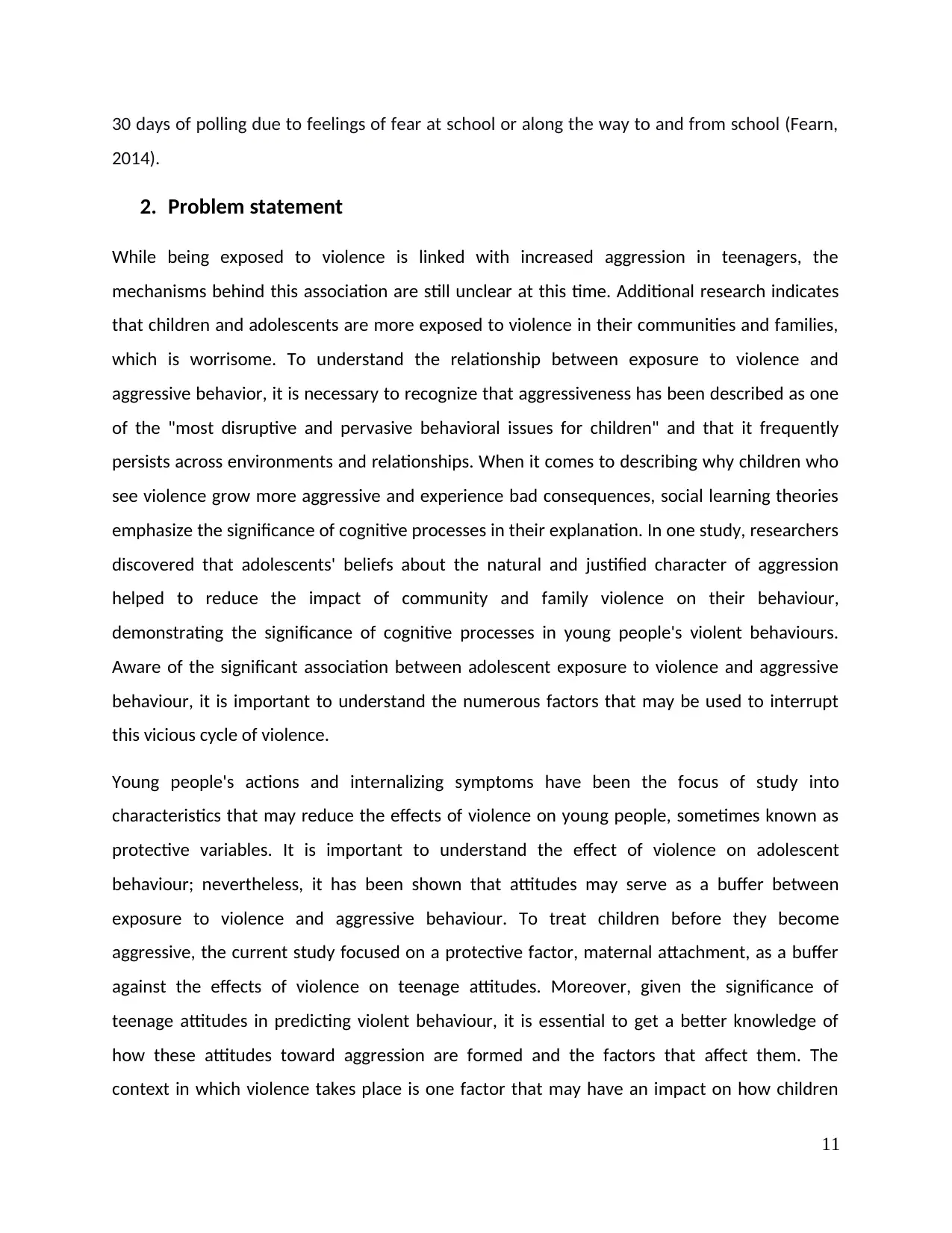
30 days of polling due to feelings of fear at school or along the way to and from school (Fearn,
2014).
2. Problem statement
While being exposed to violence is linked with increased aggression in teenagers, the
mechanisms behind this association are still unclear at this time. Additional research indicates
that children and adolescents are more exposed to violence in their communities and families,
which is worrisome. To understand the relationship between exposure to violence and
aggressive behavior, it is necessary to recognize that aggressiveness has been described as one
of the "most disruptive and pervasive behavioral issues for children" and that it frequently
persists across environments and relationships. When it comes to describing why children who
see violence grow more aggressive and experience bad consequences, social learning theories
emphasize the significance of cognitive processes in their explanation. In one study, researchers
discovered that adolescents' beliefs about the natural and justified character of aggression
helped to reduce the impact of community and family violence on their behaviour,
demonstrating the significance of cognitive processes in young people's violent behaviours.
Aware of the significant association between adolescent exposure to violence and aggressive
behaviour, it is important to understand the numerous factors that may be used to interrupt
this vicious cycle of violence.
Young people's actions and internalizing symptoms have been the focus of study into
characteristics that may reduce the effects of violence on young people, sometimes known as
protective variables. It is important to understand the effect of violence on adolescent
behaviour; nevertheless, it has been shown that attitudes may serve as a buffer between
exposure to violence and aggressive behaviour. To treat children before they become
aggressive, the current study focused on a protective factor, maternal attachment, as a buffer
against the effects of violence on teenage attitudes. Moreover, given the significance of
teenage attitudes in predicting violent behaviour, it is essential to get a better knowledge of
how these attitudes toward aggression are formed and the factors that affect them. The
context in which violence takes place is one factor that may have an impact on how children
11
2014).
2. Problem statement
While being exposed to violence is linked with increased aggression in teenagers, the
mechanisms behind this association are still unclear at this time. Additional research indicates
that children and adolescents are more exposed to violence in their communities and families,
which is worrisome. To understand the relationship between exposure to violence and
aggressive behavior, it is necessary to recognize that aggressiveness has been described as one
of the "most disruptive and pervasive behavioral issues for children" and that it frequently
persists across environments and relationships. When it comes to describing why children who
see violence grow more aggressive and experience bad consequences, social learning theories
emphasize the significance of cognitive processes in their explanation. In one study, researchers
discovered that adolescents' beliefs about the natural and justified character of aggression
helped to reduce the impact of community and family violence on their behaviour,
demonstrating the significance of cognitive processes in young people's violent behaviours.
Aware of the significant association between adolescent exposure to violence and aggressive
behaviour, it is important to understand the numerous factors that may be used to interrupt
this vicious cycle of violence.
Young people's actions and internalizing symptoms have been the focus of study into
characteristics that may reduce the effects of violence on young people, sometimes known as
protective variables. It is important to understand the effect of violence on adolescent
behaviour; nevertheless, it has been shown that attitudes may serve as a buffer between
exposure to violence and aggressive behaviour. To treat children before they become
aggressive, the current study focused on a protective factor, maternal attachment, as a buffer
against the effects of violence on teenage attitudes. Moreover, given the significance of
teenage attitudes in predicting violent behaviour, it is essential to get a better knowledge of
how these attitudes toward aggression are formed and the factors that affect them. The
context in which violence takes place is one factor that may have an impact on how children
11
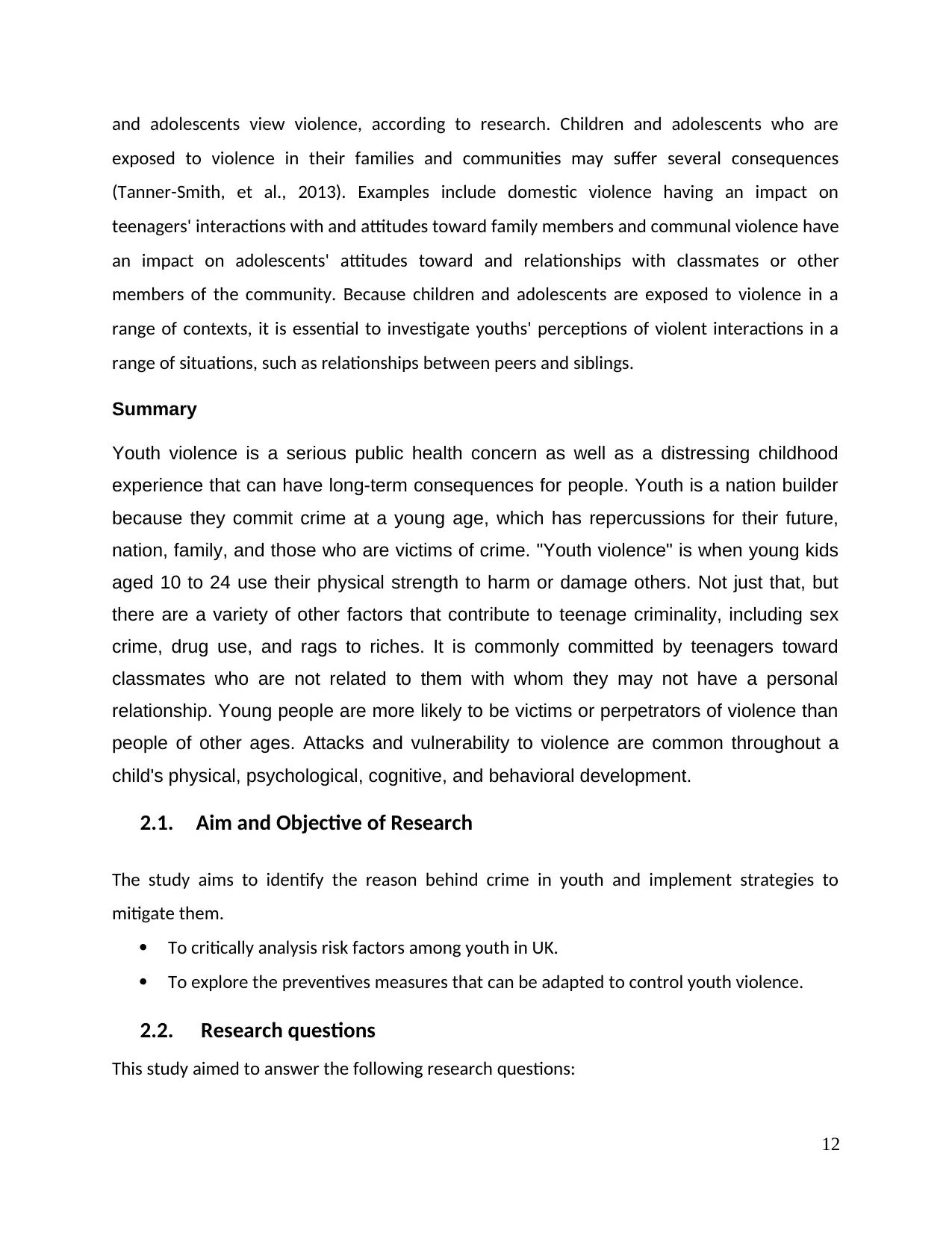
and adolescents view violence, according to research. Children and adolescents who are
exposed to violence in their families and communities may suffer several consequences
(Tanner-Smith, et al., 2013). Examples include domestic violence having an impact on
teenagers' interactions with and attitudes toward family members and communal violence have
an impact on adolescents' attitudes toward and relationships with classmates or other
members of the community. Because children and adolescents are exposed to violence in a
range of contexts, it is essential to investigate youths' perceptions of violent interactions in a
range of situations, such as relationships between peers and siblings.
Summary
Youth violence is a serious public health concern as well as a distressing childhood
experience that can have long-term consequences for people. Youth is a nation builder
because they commit crime at a young age, which has repercussions for their future,
nation, family, and those who are victims of crime. "Youth violence" is when young kids
aged 10 to 24 use their physical strength to harm or damage others. Not just that, but
there are a variety of other factors that contribute to teenage criminality, including sex
crime, drug use, and rags to riches. It is commonly committed by teenagers toward
classmates who are not related to them with whom they may not have a personal
relationship. Young people are more likely to be victims or perpetrators of violence than
people of other ages. Attacks and vulnerability to violence are common throughout a
child's physical, psychological, cognitive, and behavioral development.
2.1. Aim and Objective of Research
The study aims to identify the reason behind crime in youth and implement strategies to
mitigate them.
To critically analysis risk factors among youth in UK.
To explore the preventives measures that can be adapted to control youth violence.
2.2. Research questions
This study aimed to answer the following research questions:
12
exposed to violence in their families and communities may suffer several consequences
(Tanner-Smith, et al., 2013). Examples include domestic violence having an impact on
teenagers' interactions with and attitudes toward family members and communal violence have
an impact on adolescents' attitudes toward and relationships with classmates or other
members of the community. Because children and adolescents are exposed to violence in a
range of contexts, it is essential to investigate youths' perceptions of violent interactions in a
range of situations, such as relationships between peers and siblings.
Summary
Youth violence is a serious public health concern as well as a distressing childhood
experience that can have long-term consequences for people. Youth is a nation builder
because they commit crime at a young age, which has repercussions for their future,
nation, family, and those who are victims of crime. "Youth violence" is when young kids
aged 10 to 24 use their physical strength to harm or damage others. Not just that, but
there are a variety of other factors that contribute to teenage criminality, including sex
crime, drug use, and rags to riches. It is commonly committed by teenagers toward
classmates who are not related to them with whom they may not have a personal
relationship. Young people are more likely to be victims or perpetrators of violence than
people of other ages. Attacks and vulnerability to violence are common throughout a
child's physical, psychological, cognitive, and behavioral development.
2.1. Aim and Objective of Research
The study aims to identify the reason behind crime in youth and implement strategies to
mitigate them.
To critically analysis risk factors among youth in UK.
To explore the preventives measures that can be adapted to control youth violence.
2.2. Research questions
This study aimed to answer the following research questions:
12
⊘ This is a preview!⊘
Do you want full access?
Subscribe today to unlock all pages.

Trusted by 1+ million students worldwide
1 out of 54
Related Documents
Your All-in-One AI-Powered Toolkit for Academic Success.
+13062052269
info@desklib.com
Available 24*7 on WhatsApp / Email
![[object Object]](/_next/static/media/star-bottom.7253800d.svg)
Unlock your academic potential
Copyright © 2020–2025 A2Z Services. All Rights Reserved. Developed and managed by ZUCOL.



